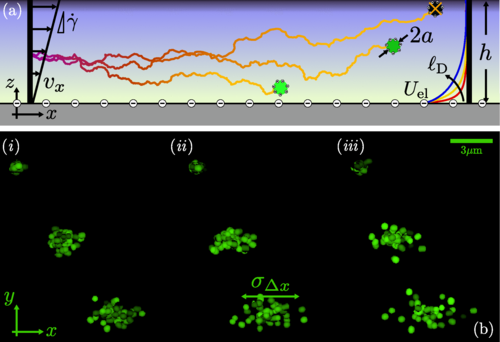 The dispersive spreading of microscopic particles in shear flows is influenced both by advection and thermal motion. At the nanoscale, interactions between such particles and their confining boundaries become unavoidable. We address the roles of electrostatic repulsion and absorption on the spatial distribution and dispersion of charged nanoparticles in near-surface shear flows, observed under evanescent illumination. The electrostatic repulsion between particles and the lower charged surface is tuned by varying electrolyte concentrations. Particles leaving the field of vision can be neglected from further analysis, such that the experimental ensemble is equivalent to that of Taylor dispersion with absorption. These two ingredients modify the particle distribution, deviating strongly from the Gibbs-Boltzmann form at the nanoscale studied here. The overall effect is to restrain the accessible space available to particles, which leads to a striking, tenfold reduction in the spreading dynamics as compared to the noninteracting case.
The dispersive spreading of microscopic particles in shear flows is influenced both by advection and thermal motion. At the nanoscale, interactions between such particles and their confining boundaries become unavoidable. We address the roles of electrostatic repulsion and absorption on the spatial distribution and dispersion of charged nanoparticles in near-surface shear flows, observed under evanescent illumination. The electrostatic repulsion between particles and the lower charged surface is tuned by varying electrolyte concentrations. Particles leaving the field of vision can be neglected from further analysis, such that the experimental ensemble is equivalent to that of Taylor dispersion with absorption. These two ingredients modify the particle distribution, deviating strongly from the Gibbs-Boltzmann form at the nanoscale studied here. The overall effect is to restrain the accessible space available to particles, which leads to a striking, tenfold reduction in the spreading dynamics as compared to the noninteracting case.
PHYSICAL REVIEW LETTERS
By: Alexandre Vilquin, Vincent Bertin, Elie Raphaël, David S. Dean, Thomas Salez, Joshua D. McGraw.
Phys. Rev. Lett. 130, 038201 – Published 19 January 2023
DOI: https://journals.aps.org/prl/abstra...

